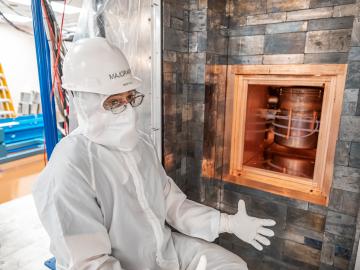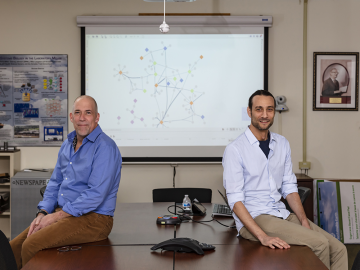
Filter News
Area of Research
- Advanced Manufacturing (3)
- Biology and Environment (20)
- Biology and Soft Matter (1)
- Computational Biology (1)
- Computational Engineering (1)
- Computer Science (5)
- Electricity and Smart Grid (1)
- Energy Science (26)
- Functional Materials for Energy (1)
- Fusion and Fission (8)
- Fusion Energy (1)
- Isotopes (4)
- Materials (47)
- Materials for Computing (4)
- National Security (7)
- Neutron Science (13)
- Nuclear Science and Technology (4)
- Quantum information Science (1)
- Supercomputing (49)
News Type
News Topics
- (-) Artificial Intelligence (100)
- (-) Chemical Sciences (59)
- (-) Composites (25)
- (-) Frontier (48)
- (-) Physics (44)
- (-) Space Exploration (24)
- 3-D Printing/Advanced Manufacturing (106)
- Advanced Reactors (30)
- Big Data (66)
- Bioenergy (90)
- Biology (106)
- Biomedical (57)
- Biotechnology (28)
- Buildings (57)
- Clean Water (30)
- Computer Science (169)
- Coronavirus (34)
- Critical Materials (18)
- Cybersecurity (23)
- Education (2)
- Emergency (4)
- Energy Storage (79)
- Environment (178)
- Exascale Computing (54)
- Fossil Energy (7)
- Fusion (56)
- Grid (57)
- High-Performance Computing (104)
- Hydropower (12)
- Irradiation (3)
- Isotopes (46)
- ITER (8)
- Machine Learning (53)
- Materials (118)
- Materials Science (109)
- Mathematics (11)
- Mercury (10)
- Microelectronics (3)
- Microscopy (42)
- Molten Salt (8)
- Nanotechnology (41)
- National Security (70)
- Neutron Science (122)
- Nuclear Energy (98)
- Partnerships (43)
- Polymers (23)
- Quantum Computing (41)
- Quantum Science (63)
- Security (20)
- Simulation (55)
- Software (1)
- Statistics (3)
- Summit (50)
- Transportation (77)
Media Contacts

For nearly six years, the Majorana Demonstrator quietly listened to the universe. Nearly a mile underground at the Sanford Underground Research Facility, or SURF, in Lead, South Dakota, the experiment collected data that could answer one of the most perplexing questions in physics: Why is the universe filled with something instead of nothing?

Researchers from Yale University and ORNL collaborated on neutron scattering experiments to study hydrogen atom locations and their effects on iron in a compound similar to those commonly used in industrial catalysts.

Researchers at ORNL zoomed in on molecules designed to recover critical materials via liquid-liquid extraction — a method used by industry to separate chemically similar elements.

Critical Materials Institute researchers at Oak Ridge National Laboratory and Arizona State University studied the mineral monazite, an important source of rare-earth elements, to enhance methods of recovering critical materials for energy, defense and manufacturing applications.

Seven scientists at the Department of Energy’s Oak Ridge National Laboratory have been named Battelle Distinguished Inventors, in recognition of their obtaining 14 or more patents during their careers at the lab.

ORNL’s next major computing achievement could open a new universe of scientific possibilities accelerated by the primal forces at the heart of matter and energy.

The presence of minerals called ash in plants makes little difference to the fitness of new naturally derived compound materials designed for additive manufacturing, an Oak Ridge National Laboratory-led team found.

John “Jack” Cahill is out to illuminate previously unseen processes with new technology, advancing our understanding of how chemicals interact to influence complex systems whether it’s in the human body or in the world beneath our feet.

Eight ORNL scientists are among the world’s most highly cited researchers, according to a bibliometric analysis conducted by the scientific publication analytics firm Clarivate.

ORNL researchers discovered genetic mutations that underlie autism using a new approach that could lead to better diagnostics and drug therapies.


